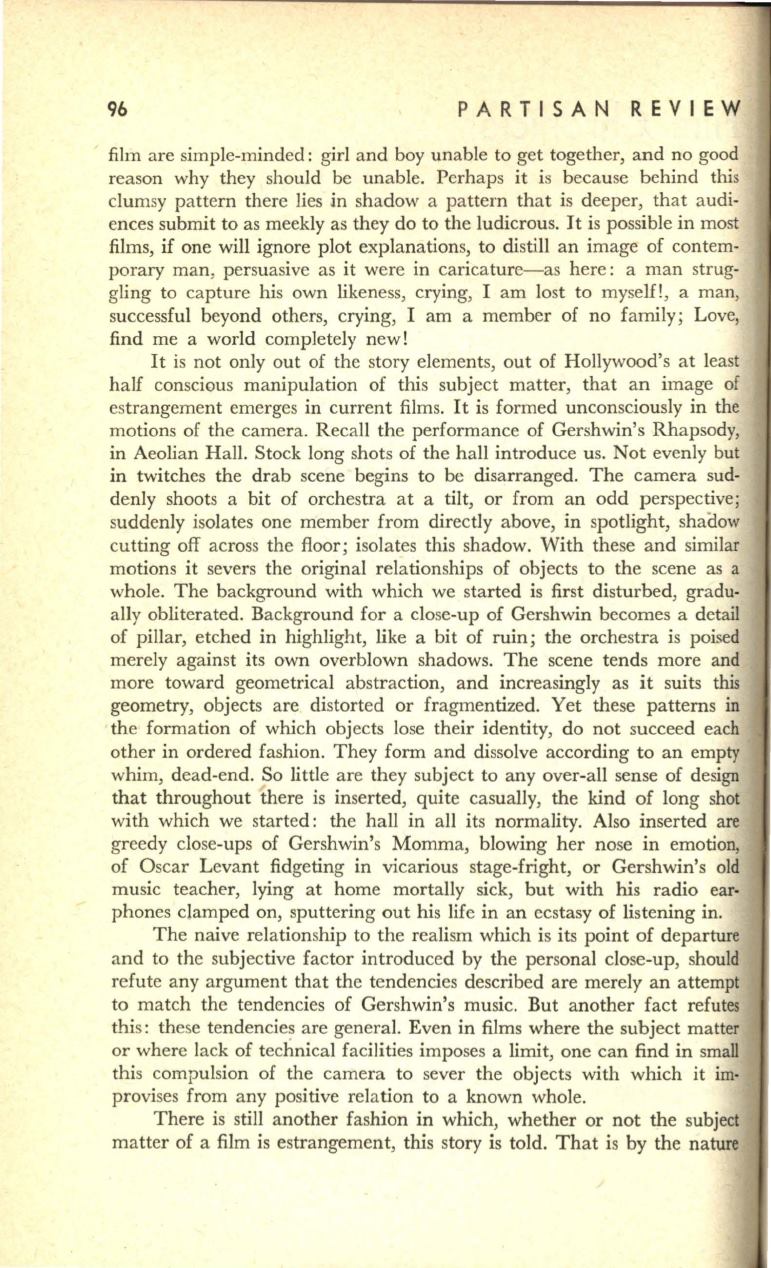
96
PARTISAN REVIEW
film are simple-minded: girl and boy unable to get together, and no good
reason why they should be unable. Perhaps it is because behind this
clumsy pattern there lies in shadow a pattern that is deeper, that audi–
ences submit to as meekly as they do to the ludicrous. It is possible in most
films, if one will ignore plot explanations, to distill an image of contem–
porary man, persuasive as it were in caricature-as here: a man strug–
gling to capture his own likeness, crying, I am lost to myself!, a man,
successful beyond others, crying, I am a member of no family; Love,
find me a world completely new!
It
is not only out of the story elements, out of Hollywood's at least
half consci0us manipulation of this subject matter, that an image of
estrangement emerges in current films. It is formed unconsciously in the
motions of the camera. Recall the performance of Gershwin's Rhapsody,
in Aeolian Hall. Stock long shots of the hall introduce us. Not evenly but
in twitches the drab scene begins to be disarranged. The camera sud–
denly shoots a bit of orchestra at a tilt, or from an odd perspective;
suddenly isolates one member from directly above, in spotlight, shaaow
cutting off across the floor; isolates this shadow. With these and similar
motions it severs the original relationships of objects to the scene as a
whole. The background with which we started is first disturbed, gradu–
ally obliterated. Background for a close-up of Gershwin becomes a detail
of pillar, etched in highlight, like a bit of ruin; the orchestra is poised
merely against its own overblown shadows. The scene tends more and
more toward geometrical abstraction, and increasingly as it suits this
geometry, objects are distorted or fragmentized. Yet these patterns in
the formation of which objects lose their identity, do not succeed each
other in ordered fashion. They form and dissolve according to an empty
whim, dead-end. So little are they subject to any over-all sense of design
that throughout there is inserted, quite casually, the kind of long shot
with which we started : the hall in all its normality. Also inserted are
greedy close-ups of Gershwin's Momma, blowing her nose in emotion,
of Oscar Levant fidgeting in vicarious stage-fright, or Gershwin's old
music teacher, lying at home mortally sick, but with his radio ear–
phones clamped on, sputtering out his life in an ecstasy of listening in.
The naive relationship to the realism which is its point of departure
and to the subjective factor introduced by the personal close-up, should
refute any argument that the tendencies described are merely an attempt
to match the tendencies of Gershwin's music. But another fact refutes
this: these tendencies are general. Even in films where the subject matter
or where lack of technical facilities imposes a limit, one can find in small
this compulsion of the camera to sever the objects with which it im–
provises from any positive relation to a known whole.
There is still another fashion in which, whether or not the subject
matter of a film is estrangement, this story is told. That is by the nature


